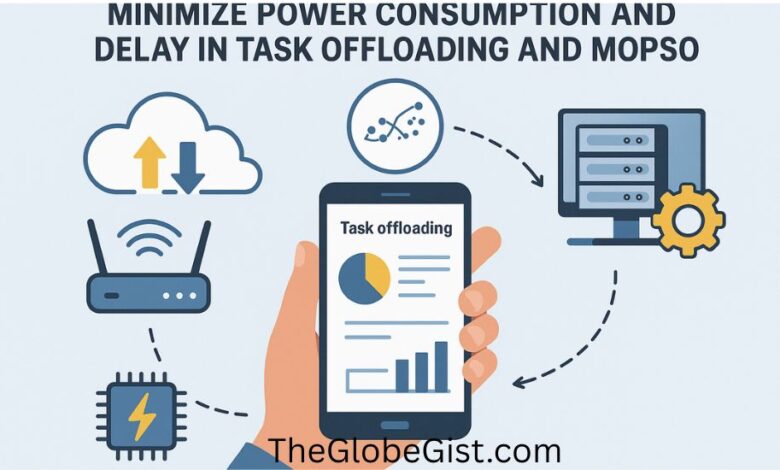Minimize Power Consumption and Delay in Task Offloading with MOPSO

In the age of mobile computing, Internet of Things (IoT), and high-demand applications, efficient resource management has become a cornerstone of system performance. Mobile Edge Computing (MEC) and cloud-based platforms have emerged to bring computation closer to users, reducing latency and optimizing performance. However, this comes with a persistent challenge—how to minimize power consumption and delay in task offloading without sacrificing performance.
One effective solution is Multi-Objective Particle Swarm Optimization (MOPSO), an advanced variant of Particle Swarm Optimization (PSO) that can simultaneously optimize multiple conflicting objectives, such as reducing energy consumption and minimizing delay. This article dives deep into how MOPSO can be applied in task offloading scenarios, its benefits, challenges, and the latest research trends.
Understanding Task Offloading in Modern Computing
Task offloading refers to the process of transferring computational tasks from a local device (such as a smartphone, IoT sensor, or autonomous vehicle) to remote computing infrastructure like MEC servers or the cloud. This strategy is widely used to overcome the limitations of devices with constrained computational resources and battery capacity.
Offloading decisions depend on various factors:
-
Device capability: CPU, memory, and storage limitations
-
Network conditions: Bandwidth, jitter, and latency
-
Energy constraints: Battery level and consumption patterns
-
Application requirements: Time-sensitive or computation-intensive workloads
The objective is to determine which tasks to offload, where to offload them, and how much data to send, while meeting the twin goals of low energy use and low delay.
The Challenge: Balancing Energy and Delay
When tasks are processed locally, delay is low (no transmission overhead), but energy consumption can be high, especially for computation-heavy workloads. Conversely, when tasks are offloaded to edge or cloud servers, energy usage on the local device may decrease, but network delay could increase, particularly in congested environments.
This creates a trade-off:
-
Minimizing power consumption may involve offloading more work, but it risks higher delays.
-
Minimizing delay may involve processing tasks locally, but it consumes more power.
A good optimization strategy must balance both objectives to provide the best user experience.
Introduction to Multi-Objective Particle Swarm Optimization (MOPSO)
Particle Swarm Optimization (PSO) is a population-based stochastic optimization technique inspired by the social behavior of birds and fish. Each “particle” represents a candidate solution, which moves through the solution space influenced by:
-
Its own best experience (personal best)
-
The best solution found by the swarm (global best)
MOPSO extends PSO to handle multiple objectives simultaneously. Instead of finding a single optimal point, MOPSO generates a set of Pareto-optimal solutions—solutions where no objective can be improved without worsening another.
For task offloading, MOPSO can simultaneously optimize:
-
Energy consumption
-
Execution delay
-
Possibly other factors like bandwidth utilization, cost, or load balancing
How MOPSO Works in Task Offloading Scenarios
The general workflow for applying MOPSO in task offloading is:
-
Problem Formulation
-
Define decision variables (e.g., offloading ratio, server selection, transmit power)
-
Set objective functions (e.g., minimize energy
E, minimize delayT) -
Incorporate constraints (e.g., task deadlines, bandwidth limits)
-
-
Particle Representation
-
Each particle encodes a possible offloading strategy:
Example:(offload_task1_to_edge, offload_task2_local, transmit_power_level, bandwidth_allocation)
-
-
Initialization
-
Generate an initial swarm of random solutions within feasible ranges.
-
-
Fitness Evaluation
-
Calculate delay and energy consumption for each particle using system models.
-
-
Update Rules
-
Update particle velocities and positions based on personal best and swarm best.
-
Maintain an external archive of non-dominated solutions.
-
-
Pareto Front Construction
-
Keep solutions that balance energy and delay trade-offs.
-
-
Decision Selection
-
From the Pareto set, select a strategy that best matches the application’s needs.
-
Research and Applications of MOPSO in Energy-Delay Optimization
1. Industrial IoT Applications
Studies have shown that MOPSO can be highly effective in Industrial Internet of Things (IIoT) task scheduling, where heavy workloads require careful balancing of energy and delay. By representing each machine or device as a node in the optimization model, researchers have reduced both power consumption and processing time.
2. Vehicular Edge Computing (VEC)
In vehicular networks, MOPSO-based algorithms help offload navigation, object recognition, and safety-critical processing to roadside edge servers. Research has found up to 16% reduction in energy and 15% reduction in average task delay compared to traditional offloading schemes.
3. Healthcare and Remote Monitoring
For telemedicine applications, MOPSO ensures real-time patient monitoring data is processed without draining wearable device batteries, while also keeping medical response times low.
4. Multi-Tier Cloud-Edge Architectures
Some systems use three-tier task offloading (device → edge → cloud). MOPSO optimizes decisions across all layers, balancing the immediate low-latency benefits of the edge with the higher computational capacity of the cloud.
Benefits of Using MOPSO for Task Offloading
-
Multi-objective handling: Simultaneously optimizes delay and power consumption.
-
Flexibility: Can integrate other objectives like cost, load balancing, or fairness.
-
Scalability: Can handle large swarms and complex network topologies.
-
Adaptability: Can dynamically adjust to changing network conditions or workloads.
Limitations and Challenges
Despite its advantages, MOPSO faces some limitations:
-
Computational overhead: The optimization itself consumes resources.
-
Convergence issues: May require careful parameter tuning to avoid premature convergence.
-
Dynamic environments: Rapid changes in network state may require frequent re-optimization.
-
Complex implementation: More challenging to implement than single-objective algorithms.
Strategies to Improve MOPSO Performance in Task Offloading
-
Hybrid Algorithms
Combining MOPSO with other techniques like Genetic Algorithms (GA) or Grey Wolf Optimization (GWO) can enhance exploration and exploitation balance. -
Adaptive Parameter Control
Dynamically adjusting inertia weight, cognitive coefficients, and social coefficients helps MOPSO adapt to changing conditions. -
Clustering-based Preprocessing
Grouping similar tasks before optimization can reduce the search space and improve convergence. -
Integration with Machine Learning
Using predictive models to estimate task delay and energy use helps MOPSO evaluate particles more accurately.
Future Research Directions
The next generation of MOPSO-based offloading strategies will likely focus on:
-
Edge-AI synergy: Real-time learning to enhance decision-making.
-
5G/6G integration: Exploiting ultra-low-latency networks for improved offloading.
-
Security-aware optimization: Incorporating privacy and security constraints into the objectives.
-
Energy harvesting devices: Optimizing in contexts where devices can recharge from environmental energy sources.
Conclusion
The goal to minimize power consumption and delay in task offloading is vital in the modern computing era, especially with the rise of IoT, autonomous vehicles, and smart cities. MOPSO provides a powerful, flexible, and efficient method for balancing these competing goals by generating Pareto-optimal solutions.
By leveraging MOPSO’s multi-objective optimization capability, developers and researchers can design systems that are both energy-efficient and responsive, ultimately enhancing user experiences across industries—from healthcare and manufacturing to transportation and entertainment.
As advancements in edge computing, AI, and network infrastructure continue, MOPSO-based approaches will become an even more critical part of the optimization toolbox for next-generation distributed systems.
The Globe Gist will continue to explore and share insights on such cutting-edge solutions that push the boundaries of technological efficiency and performance.
Thanks for read our article if ou want more like this kind of article visit our site The Globe Gist and comment us.



